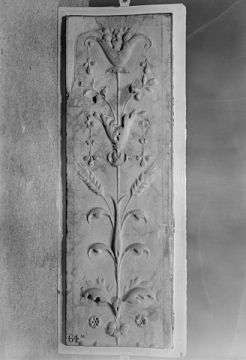Explore Collections


You are here:
CollectionsOnline
/
Fragmentary section of an enriched pilaster shaft
Browse
Fragmentary section of an enriched pilaster shaft
14-70 AD
Julio-Claudian
Julio-Claudian
Pavonazzetto marble
Height: 54cm
Width: 18cm
Width: 18cm
Museum number: M64
On display: Museum Corridor - outside the Picture Room
All spaces are in No. 13 Lincoln's Inn Fields unless identified as in No. 12, Soane's first house.
For tours https://www.soane.org/your-visit
Curatorial note
Carved with stylised Arabesque acanthus vine, floral foliage with rosettes and tendril flowers springing left and right from a central stem.
The ornament can be compared with a more complete example of this decorative style on a pillar in the Museo Chiaramonti1. The lower part of the exposed side of the Vatican example shows the frequent type of this "Arabesque" foliage springing from a decorative vase at the bottom of the composition. There are several other examples very similar to this piece built into the shelving of the Museo Chiaramonti, which taken together all give an excellent picture of the various decorative motives practised on carved pillars during the Roman Imperial period2. Also comparable for general arrangement is a sculptured pilaster from the Cook collection at Richmond of which Mrs. Strong stated that the elegant and somewhat schematic decoration points to a dating in the Augustan age3. The Soane example might, from the slight "heaviness" in the leaf work and the touches of drill be placed at a slightly later date, early in the Julio-Claudian period proper. Both are very close to parallel Renaissance work based on the antique.
In the cloisters of the convent of Ara Coeli near Rome are two pilasters of possibly Phrygian marble with arabesque enrichment recalling but seemingly later than the Soane example4. Both these examples are surmounted by capitals characteristic of Hadrianic enrichment on this scale, a circumstance which would not be out of place with our notions of Hadrianic classicism and the continuity of Greek decorative forms. If we return to the Augustan period and the direct prototypes for the delicate carving of the High Renaissance in Rome (as witnessed by the secondary decoration of the Julius tomb in San Pietro in Vincoli), analogous care in refined foliate detail is seen in the fine, flowered scrollwork of the large pilasters flanking the central side-portals of the Basilica Aemilia and in similar fragments found in or brought from this site.
1W. Amelung, Die Skulpturen des Vaticanischen Museums, Berlin, 1903-08, Volume 1 - 1903; volume 2 - 1908, I, p. 454, no. D 211, pl. 46.
2See also loc. cit., pls. 35, 39.
3Journal of Hellenic Studies, XXVIII, 1908, p. 25, no. 33a., fig. 5; now in the Ashmolean Museum, Oxford.
4Speltz, A, Styles of Ornament from Prehistoric Times to the Middle of the Nineteenth Century, trans. and ed. R.P. Spiers, London and Leipzig, 1910 pl. 38, nos. 1, 5.
The ornament can be compared with a more complete example of this decorative style on a pillar in the Museo Chiaramonti1. The lower part of the exposed side of the Vatican example shows the frequent type of this "Arabesque" foliage springing from a decorative vase at the bottom of the composition. There are several other examples very similar to this piece built into the shelving of the Museo Chiaramonti, which taken together all give an excellent picture of the various decorative motives practised on carved pillars during the Roman Imperial period2. Also comparable for general arrangement is a sculptured pilaster from the Cook collection at Richmond of which Mrs. Strong stated that the elegant and somewhat schematic decoration points to a dating in the Augustan age3. The Soane example might, from the slight "heaviness" in the leaf work and the touches of drill be placed at a slightly later date, early in the Julio-Claudian period proper. Both are very close to parallel Renaissance work based on the antique.
In the cloisters of the convent of Ara Coeli near Rome are two pilasters of possibly Phrygian marble with arabesque enrichment recalling but seemingly later than the Soane example4. Both these examples are surmounted by capitals characteristic of Hadrianic enrichment on this scale, a circumstance which would not be out of place with our notions of Hadrianic classicism and the continuity of Greek decorative forms. If we return to the Augustan period and the direct prototypes for the delicate carving of the High Renaissance in Rome (as witnessed by the secondary decoration of the Julius tomb in San Pietro in Vincoli), analogous care in refined foliate detail is seen in the fine, flowered scrollwork of the large pilasters flanking the central side-portals of the Basilica Aemilia and in similar fragments found in or brought from this site.
1W. Amelung, Die Skulpturen des Vaticanischen Museums, Berlin, 1903-08, Volume 1 - 1903; volume 2 - 1908, I, p. 454, no. D 211, pl. 46.
2See also loc. cit., pls. 35, 39.
3Journal of Hellenic Studies, XXVIII, 1908, p. 25, no. 33a., fig. 5; now in the Ashmolean Museum, Oxford.
4Speltz, A, Styles of Ornament from Prehistoric Times to the Middle of the Nineteenth Century, trans. and ed. R.P. Spiers, London and Leipzig, 1910 pl. 38, nos. 1, 5.
Rome; collected in Rome by Charles Heathcote Tatham for the architect Henry Holland during the 1790s. See Cornelius Vermeule, unpublished Catalogue of the Antiquities at Sir John Soane's Museum, Introduction, transcription of Tatham letters, List 2, no.71.
Literature
Tatham: Etchings, 10; Drawings, 2.
Marion Mathea-Förtsch, Römische Rankenpfeiler und- pilaster, Mainz, 1999, pl. 74, 1, no. 70.
Marion Mathea-Förtsch, Römische Rankenpfeiler und- pilaster, Mainz, 1999, pl. 74, 1, no. 70.
Soane collections online is being continually updated. If you wish to find out more or if you have any further information about this object please contact us: worksofart@soane.org.uk


